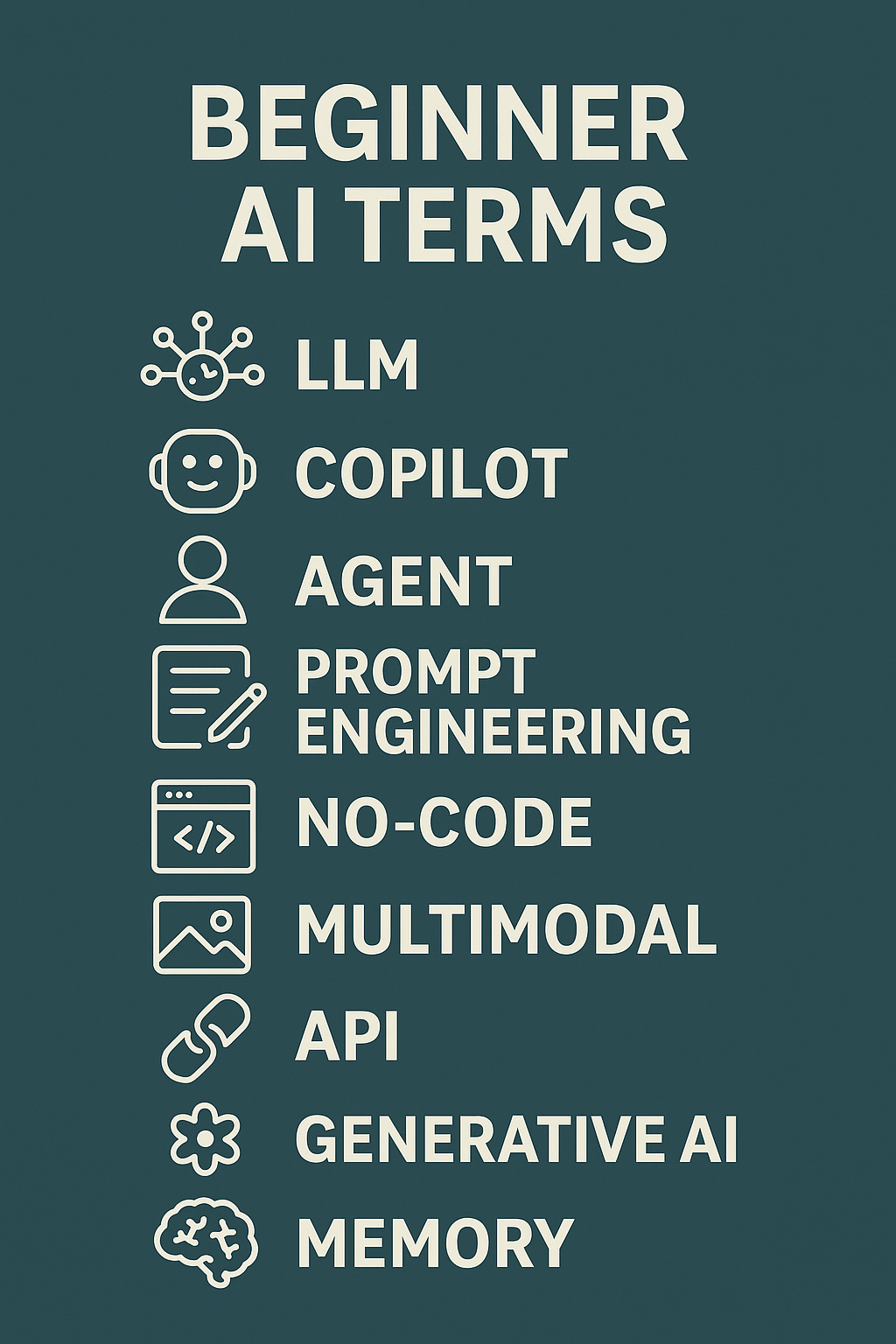The AI space is full of jargon. If you’re new to it, terms like “LLMs,” “agents,” and “multimodal” can sound intimidating. But here’s the truth: you don’t need to know everything — only the core terms that impact how you use AI every day.
This guide breaks down the AI terms you actually need to know in 2025, with examples, simple definitions, and links to practical tutorials.
👉 Beginners can start with ChatGPT for Beginners: 7 Easy Ways to Boost Productivity with AI.
👉 For advanced prompting, see 7 Proven ChatGPT Techniques Every Advanced User Should Know.
🤖 LLM (Large Language Model)
What it means: The engine powering most AI tools. Trained on billions of words, LLMs can generate text, answer questions, and solve problems.
Why it matters: Every major AI app — ChatGPT, Claude, Gemini — is powered by an LLM.
👉 Learn how updates affect you: What OpenAI’s Latest GPT Update Means for Everyday Users.
⚡ AI Copilot
What it means: An AI built into the apps you already use (Word, Excel, Gmail, browsers).
Why it matters: Copilots make productivity seamless — drafting, summarizing, and automating directly in your workflow.
👉 Full breakdown: AI Copilot Updates 2025: Smarter, Faster, and More Useful.
🧠 AI Agent
What it means: AI that can plan, act, and self-correct instead of just answering questions.
Why it matters: Agents are the backbone of “agentic AI,” where systems act like teammates.
👉 Beginner’s guide: AI Agents: Smarter, Faster, More Useful.
📚 Prompt Engineering
What it means: Writing instructions for AI in a way that gets the best results.
Why it matters: Prompts are the “language” you use to guide AI.
👉 Learn how: Prompt Chaining Made Easy: Learn with Real-World Examples.
🛠 No-Code AI
What it means: Platforms that let you build AI workflows without programming.
Why it matters: With tools like Replit, Flowise, or Make, anyone can create their own AI agent.
👉 Tutorial: No-Code AI Agents: Replit and Claude Make It Simple.
🌐 Multimodal AI
What it means: AI that works across multiple formats — text, images, voice, and video.
Why it matters: Tools like Gemini and GPT-5 can now process an image, describe it, and answer questions about it.
🔗 API (Application Programming Interface)
What it means: A way for different apps to “talk” to each other.
Why it matters: APIs allow AI tools to connect with Notion, Zapier, or Trello to take real-world actions.
👉 See: How to Build Complex Workflows with AI Copilots and Zapier.
🧩 Agentic AI
What it means: AI designed to operate with autonomy, not just reactively.
Why it matters: This is the next big wave Big Tech is investing in.
👉 Read more: Big Tech and Agentic AI: What It Means for You.
📈 Fine-Tuning
What it means: Customizing an AI model by training it on specific data.
Why it matters: Fine-tuned AIs can perform better on niche tasks (like customer support for your business).
📂 Memory in AI
What it means: The ability of AI to remember past interactions or user preferences.
Why it matters: It makes agents more personal and useful over time. Perplexity and Claude are already rolling this out.
🎨 Generative AI
What it means: AI that creates new content (text, art, music, video).
Why it matters: Generative AI powers apps like MidJourney (art), ElevenLabs (voice), and ChatGPT (text).
👉 Explore: Top 5 Free AI Tools You Can Start Using Today.
🚀 Supervised vs. Reinforcement Learning
- Supervised: AI trained on labeled examples (“this is a cat”).
- Reinforcement: AI learns by trial and error, like teaching it to play chess.
Why it matters: These are the methods behind how AI gets smarter.
📌 Quick Reference List of Must-Know AI Terms
- LLM – The brains behind AI text tools.
- Copilot – AI built into apps you already use.
- Agent – Autonomous AI teammate.
- Prompt Engineering – Writing better instructions.
- No-Code AI – Building with drag-and-drop.
- Multimodal – Text + image + audio AI.
- API – Connects AI to your apps.
- Fine-Tuning – Customizing AI.
- Memory – AI that remembers context.
- Generative AI – AI that creates.
- Agentic AI – Autonomous, proactive AI.
Final Thoughts
AI jargon doesn’t have to be overwhelming. Focus on the terms that directly impact how you use AI in daily life: LLMs, copilots, agents, prompts, and no-code workflows.
By understanding these concepts, you’ll not only get better results but also gain the confidence to explore advanced AI features as they emerge.



